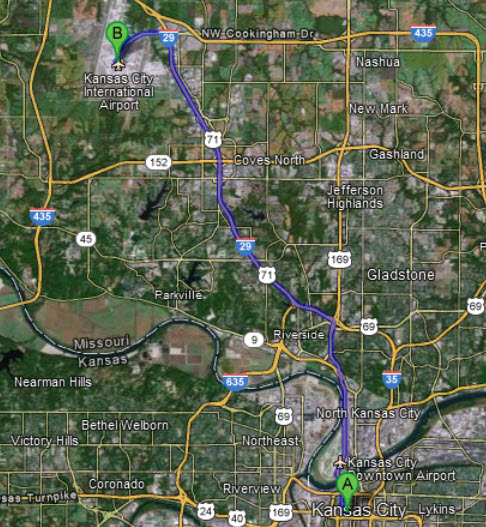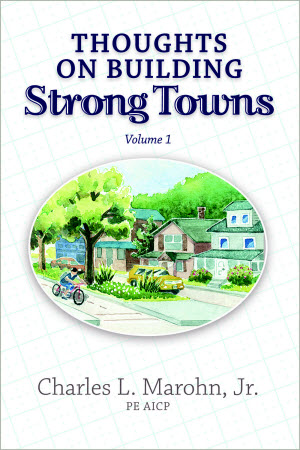Best of Blog: Crazy Ideas
There are a few times in the history of this blog where I struggle for months to explain a big idea only to, at the moment it is most needed, have the words just flow out of me like water pouring from a melting glacier. When I'm done, I have this feeling of euphoria and exhaustion, but also apprehension; I've successfully captured what I had intended, but will I reach anyone? Will it matter?
This post is one of those rare instances, and I will forever be grateful to the anonymous poster named Ruben who made the first comment. I came into the office wondering what the reaction would be -- if the angry Kansas City crowd I had called out would be there in force to shout me down -- and instead I got this:
Damn, Chuck. You are paradigm destroying.
Ruben, you don't know what that meant to me at that point in time. After pointing out the obvious (there are no cars in downtown Kansas City despite a design based almost exclusively on catering to the automobile), I got into a digital scuffle on some of the local K.C. discussion boards. They had called my observations silly and my recommendations "crazy" and when I went against my own rules (should not do that) and responded (angrily, thus the rules) that it was only a crazy idea because their brains were too closed to understand it, well....let's just say it wasn't mine finest moment. They, all too predictably, responded to my insult with the usual name calling and profanity combined with insults, etc. and....well, here we are.
Since I put this post together, I've done more research on the topic of shared space and travel time. I'm planning to delve more deeply into this in 2013 because I do believe it is paradigm destroying in a very positive way for the future of our cities.
As an epilogue to the Kansas City drama, the city has actually tried to remove some stoplights where they are clearly not needed and where the cost of maintenance far exceeds any amount they can justify given tight budgets. This has been vigorously opposed by the public who apparently enjoys longer commutes and time spent waiting for no apparent reason at signals. I'm going to be speaking in Kansas City again this February at the Smart Growth Summit and am looking forward to a (hopefully) friendly meeting with some of those I encountered online this year.
---
What exactly makes an idea crazy? Perhaps more importantly, are all crazy ideas automatically bad or not worth exploring? As the old adage goes, great ideas pass through three stages: first they are ridiculed, then violently opposed and finally accepted as being self-evident. Today I am going to try to move people from the mocking stage to violent opposition.
In my "highly inflammatory" and "overly critical" blog post on Kansas City's streets last week, I made the following statement that has drawn only ridicule from the masses:
Here are the immediate things I would do tomorrow if I were put in charge of renovating Kansas City's downtown:
4. Change all signalized intersections into a shared space area. As a temporary transition, shut off the traffic lights and paint the intersections to alert everyone that this is shared space.
The thought of a downtown without traffic signals was bizarre to many people. Don't traffic lights help with congestion? Wouldn't the downtown be more dangerous to everyone without signals? It seems like there would be anarchy and chaos. This is a crazy idea! Someone even asked me if I had heard of the MUTCD, as if it were a book in the Bible. (For non-engineers, the MUTCD, also called "the mutt", is the Manual for Uniform Traffic Control Devices).
I want people to take a step back and imagine life before the Suburban Experiment, before the development of the MUTCD and before the ubiquitous installation of traffic signals. This wasn't that long ago. Today we act as if our approach is some type of received wisdom -- the way things have always been -- but much of our population can remember the time before any traffic control at all. Traffic engineering is a young profession that is essentially making up the rules as they go along.
Traffic signals and traffic control devices are major components in a complex system. Like all complex systems where human decision-making impacts the outcomes, the relation between cause and effect is ambiguous at best. For people who reflexively argue that our current system is a wonderfully efficient and productive approach, I simply ask: as measured against what?
Where is the control group, the city without all of the signals and traffic control devices, that we can measure outcomes against? What beyond our own self assurance -- justified or otherwise -- gives us confidence that this is the best approach? Or even an approach that is one of the better alternatives? We apply the standards of the MUTCD and we've done our job. We assume it is the best approach because, if it were not, it would not be part of the MUTCD. This meme is destructively self-reinforcing.
Part of my overall argument has been that we place too much emphasis on improving the speed of the first and last minute of each trip. That approach costs us untold amounts of wealth to build, robs us of much of the productive capacity of our places and, paradoxically, actually increases the time it takes to get places.
It may be an efficient system, but it is dumb. Really, really dumb.
Let me give you one example. I stayed at the Crowne Plaza Hotel in downtown Kansas City. When I left, I flew out of the airport, which is on the edge of town. Google is telling me that this is a 19 mile trip that should take me 23 minutes. That sounds about right.
 Image and distance calculation from Google Maps.
Image and distance calculation from Google Maps.
Of the 19 miles I traveled, the first 3,700 feet were in the grid of the downtown. That is 3.7% of the distance of my trip. If I travel 30 miles per hour during that first portion of the trip, I will be out of the grid and onto Highway 169 in 1 minute and 24 seconds.
My recommendation was that the signal lights be removed and all of the intersections become shared space. Along with that, I made other recommendations that were designed to dramatically slow the speed of automobiles moving through the downtown. Slower speeds would be necessary if cars are to share the streets with pedestrians, bikers and others that should be there. And if drivers are to merge their cars with others in a shared space environment, slow speeds decrease the gap necessary to make that happen.
So what if Kansas City adopted my recommendation and went for a design speed of 15 miles per hour; half of what is currently provided for and well below any equivalent street network in the country? Halve the speed and that 3,700 feet to travel to get to on the highway now takes 2 minutes and 48 seconds.
Pause here and note that we're talking about taking a trip that is 23 minutes and making it into a trip that is 24 minutes and 48 seconds. That is not a change that is going to alter anyone's reality in terms of travel time and distance. On the other hand, if KC did not have to spend so enormously much money on maintaining streets that (my apologies Kansas Citians but) proportionately few people are using, they would have immense savings. And I'm not even talking about the financial impact of having a far more desirable downtown that would attract people and investment as well as creating a place devoid of needless traffic fatalities.
Of course, looking at the travel time this way isn't an apples to apples comparison. At the 30 mph design speed, you have signalized intersections to deal with. You can talk about "timing" all you want in theory, we all know that of the 10 signalized intersections on the way out of town, the typical driver is going to have to wait for at least one to turn.
 Photo from Google Earth. I have highlighted my route in blue and shown each signal along it with a red circle. This is the route that Google recommended, which seems quite logical.And once they do that -- once they have to stop to let just one light cycle through to green -- all of the theoretical time savings from the higher design speed disappear. In terms of getting to destinations quickly, the typical driver is far, far better off driving very slow through the grid, sharing the space without having to stop at any signals, than they are waiting to have priority given to them so they can drive at higher speeds to the next stop light.
Photo from Google Earth. I have highlighted my route in blue and shown each signal along it with a red circle. This is the route that Google recommended, which seems quite logical.And once they do that -- once they have to stop to let just one light cycle through to green -- all of the theoretical time savings from the higher design speed disappear. In terms of getting to destinations quickly, the typical driver is far, far better off driving very slow through the grid, sharing the space without having to stop at any signals, than they are waiting to have priority given to them so they can drive at higher speeds to the next stop light.
We have spent untold amounts of wealth in an effort to squeeze seconds out of the first and last mile of each auto trip. In the process, we have turned our most productive asset -- our core cities -- into low return, despotic environments that do not sufficiently attract investment capital. This would all be crazy enough in and of itself, but when you add on the realization that the approach actually makes commutes and driving times longer, you then have the very definition of insanity.
That our minds can't grasp this is what is truly crazy. When our first reaction to an idea like shared space is ridicule and scorn, even from those predisposed to be sympathetic to the idea of improving our cities, it shows just how far we have yet to go in our conversation.
And I'm sorry, Kansas City, but a rail line through the downtown is an expensive distraction. It is not a magic bullet that will create the type of prosperity you imagine it will. I get the allure -- and I'm not opposed to it -- but the problems you and other similar cities face are far more basic. And simple to solve, quite frankly. Build a productive place and you won't need to lobby for a rail line; the need for it will be self evident. You want to convince suburban voters to support placemaking improvements in the downtown? Show them how a different approach will cost less and reduce their commute time and see how quickly their opposition fades.
That's the essence of a Strong Towns approach.
 If you would like more from Chuck Marohn, check out his new book, Thoughts on Building Strong Towns (Volume 1).
If you would like more from Chuck Marohn, check out his new book, Thoughts on Building Strong Towns (Volume 1).
You can also chat with Chuck and many others about implementing a Strong Towns approach in your community by joining the Strong Towns Network. The Strong Towns Network is a social platform for those working to make their community a strong town.
